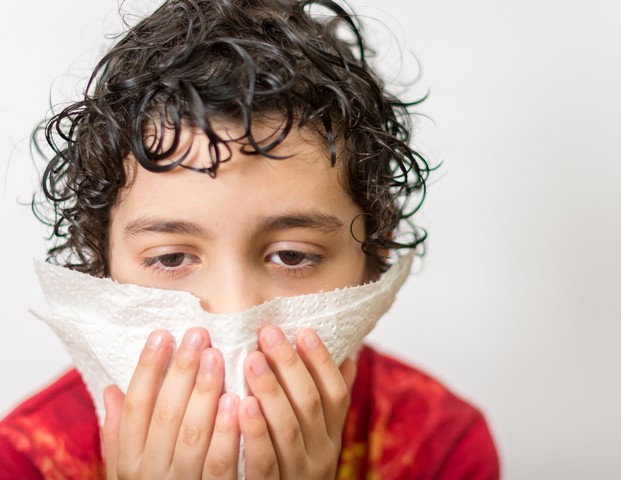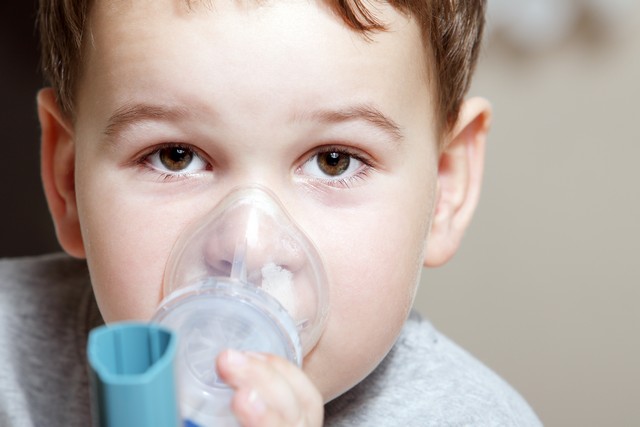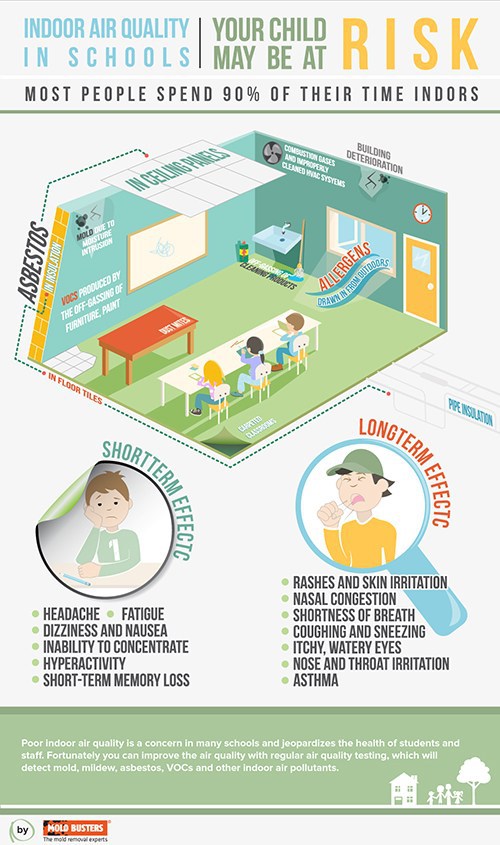Got Questions About Mold In Schools? We Have Answers!

“Once school started again, he was having breathing issues; he didn’t have any issues over the summer. This is their health and they have to breathe this in. Every single day that they are there, six hours a day that they are at school. I don’t think that’s fair to them.” (Barbara Gareau, mother of son she suspects is sick from mold)
“My child is never sick. She never has stomach problems or anything like that. It’s just weird. It’s mainly stomach pains, asthma. Some kids are having to take their allergy medicine again when they were not taking it this summer.” (Katherine Saldana, mother of daughter she suspects is sick from mold)
“Mold clung to the ceiling and left dark trails across the walls and floor. The teacher had already complained about the stench months before. Stuff was even growing on desks.” (Toxic schools: Mold, air quality spark thousands of complaints in Central Florida)
The past couple of weeks there have been several high profile stories about mold in schools in our service area of Philadelphia and Southern NJ:
- In S. Jersey school district, mold problems began long ago and kept coming back
- Kelly Elementary School remains closed Friday due to mold
The issue of mold in schools is not a recent problem. In fact, earlier this year, the Wall Street Journal published an article about mold concerns in schools.
Mold in schools has been an on-going concern for several year. In 2012, CNN ran a special report, that explored the issue of mold in schools. They focused on a third-grader, Matthew Asselin, in Winsted, Connecticut who missed 53 days of school because he was getting sick from mold at his school.
Matthew suffered from lethargy, a persistent wet cough, respiratory infections, headaches, pneumonia, and eventually got so ill that he needed to be hospitalized. His parents suspected that his school was making him ill because he was energetic and healthy during the summer holidays, but soon after starting school again, he got sick.
The purpose of this article is to help you determine if mold and the indoor air quality of your child’s school is making them sick and what you can do.
Facts About Indoor Air Quality In Schools!

According to CNN:
- It is estimated that one-third of schools have indoor air problems.
- The core cause of mold and subsequent indoor air quality issues is moisture. An easy fix you would think. However, it is not and the situation is getting worse because of budget cutbacks that make it difficult for schools to fix issues that cause moisture issues, like roof leaks.
- A national survey of school nurses found that 40% knew children and staff adversely affected by indoor pollutants.
- Indoor air affects more than health. A growing body of research suggests students also perform better in schools with healthier air.
- Asthma is the number one chronic illness that keeps kids out of school, and it’s growing
- About one in 10 children in the United States now has asthma, which causes them to miss an average of four days of school a year
- Even when children don’t miss school, the medications they take for asthma and conditions like rhinitis, an allergic reaction to mold or dust, can make it harder for them to do their best work.
- About 20% to 30% of people are susceptible to mold or dust, which triggers an allergic reaction. The resulting symptoms can include itchy eyes, runny nose, coughing, headaches, fatigue, even memory problems and slowed thinking. It takes very little exposure once you’re sensitized to provoke symptoms and gets worse over time.
- Children are not the only ones affected by poor indoor air quality, teachers and staff also get sick.
- Home schooling is growing amongst parents that are concerned that the air quality of their child’s school is not healthy.
Is Your Child’s Asthma Worse Because Of Mold In Their School?

We have written about mold and asthma several times:
-
- Asthma, mold, and indoor air quality
- World Asthma Day
- 11 Things To Stop Doing If You Have Mold Induced Asthma
Highlighted below is information that pertains directly to the issue of mold and asthma with respect to children.
One of the most common health concerns for children is asthma.
One study based on a survey of more than 10,000 university students, cited that there was a strong correlation between mold and asthma.
Another study of 300 children found a strong correlation that three species of mold–Aspergillus ochraceus, Aspergillus unguis and Penicillium variabile–caused asthma in children. The studies author went on to conclude that: “It’s proof of common sense that you want to take care of mold in the home. It’s just proving that if you don’t do that, your kids are more likely to develop asthma.”
December, 2013 the New York City Housing Authority was forced to recognize mold as a health threat and specifically that one of the core causes of asthma was moisture and mold.
It would appear that more research is pointing to the fact that the prevalent and core cause of asthma in children is mold.
Research out of Taiwan, provides even more proof that mold causes asthma.
The researchers studied school children aged 6 to 15 years old in 44 schools and concluded that:
“Classroom Aspergillus/Penicillium and basidiospores are significantly associated with childhood asthma and asthma with symptoms reduced on holidays or weekends (ASROH). Government health policy should explore environmental interventions for the elimination of fungal spores in classrooms to reduce the prevalence of childhood asthma.”
Based on this conclusion, it is fairly clear that parents, teachers, school trustees, and the government needs to take the issue of mold in schools seriously. It is no longer a theory that poor air quality affects the health of school children, it is fairly clear that it does. It is also fair to conclude that the prevalent cause of childhood asthma is mold.
If we want to reduce the number of children with asthma, then the obvious solution is to address the issue of poor air quality in schools!
As a parent, the only way you can determine if your child’s school is causing sickness is to monitor their health when they are away from school and monitor their health when they are in school.
Top 5 Questions You Must Get Answers To If If You Think Your Child’s School Has Mold!

#1 How do I know if my child is getting sick at school from mold?
Some children are more sensitive than others. But watch out for symptoms that seem to appear only at school – for example, wheezing, hoarseness, cough, runny nose, acid reflux, digestive issues, headache and irritated eyes.
#2 What should I do if my child is getting sick because of school?
Visit your children’s classrooms and other parts of their schools. Do you see or smell mold or mildew? Are there signs of water leaks on walls, around windows or on the ceiling?
Musty and earthy odors are always an indication that a mold problem is present. Dirty carpet and water damage might also mean there is mold and bad air quality. Mold grows where there’s moisture.
#3 How do I know if it’s mold?
If you see fuzzy, slimy, or discolored surfaces — especially in damp or wet areas — it’s probably mold. Molds can be green, black, gray, purple or even orange.
#4 What if I see a problem?
Alert your principal or a School Board member. A lot of times, it will take more than one call or e-mail to get a response. Although calls might be quicker, your letters will provide a paper trail. Also, be sure to log all your calls, letters and observations. Inform other parents of the problem.
#5 How can I protect my child?
Educate yourself. Talk to school officials about what they’re doing to control humidity and how quickly they’re fixing leaky roofs and windows. Ask to see copies of investigative reports and work orders for repairs and mold removal. Finally, ensure that your child is maintaining a healthy diet so their immune system is strong.
Got Mold In School Questions?

If you are concerned about mold in your home or your child’s school, please don’t hesitate to call us, 877-750-7876 or send us an e-mail.
Our team are experienced mold removal specialists that have specialized training. Peace of mind is just a phone call away. We look forward to serving you! 🙂
Concerned About Mold In Schools Summary!

Concerned About #Mold In Schools? | Philadelphia PA | Southern NJ https://t.co/OW0Rk0p79t PLEASE RETWEET pic.twitter.com/sba7fb4UYG
— Harry Allcroft (@PuroCleanPERS) October 17, 2017
